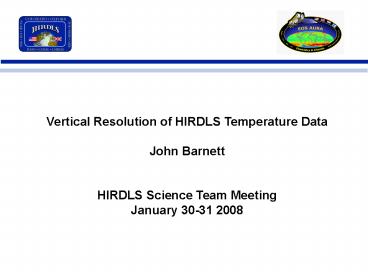Vertical Resolution of HIRDLS Temperature Data - PowerPoint PPT Presentation
1 / 14
Title:
Vertical Resolution of HIRDLS Temperature Data
Description:
This would be expected to attenuate the lowest wavenumber. Higher order polynomials gave attenuation to progressively higher frequencies ... – PowerPoint PPT presentation
Number of Views:40
Avg rating:3.0/5.0
Title: Vertical Resolution of HIRDLS Temperature Data
1
Vertical Resolution of HIRDLS Temperature
Data John Barnett HIRDLS Science Team
Meeting January 30-31 2008
2
Comparisons between COSMIC GPS radio occultation
data and HIRDLS These profiles used HIRDLS
profiles within 0.75 deg (great circle), i.e.
83.3 km and 500 sec of time of the COSMIC
profile. Sometimes 2 (possibly 3) HIRDLS profiles
matched this criterion, in which case they were
averaged together.
- Two methods of comparison were used
- Subtract a smoothed profile (this is equivalent
to a high pass filter) then intercorrelate
HIRDLS, COSMIC and GMAO. Each used its own
smoothed profile. Results for a 0.5 pressure
scale heights full width at half height filter
are shown first, then for a 0.8 FWHH filter. - Fourier analysis over the range 2.2-5.7 scale
heights, after fitting a parabola to remove the
background, and apodizing.
0.5 scaleheights approx 3.5 km
3
Example colocated COSMIC/HIRDLS comparisons
4
Main aim is to validate HIRDLS vertical
resolution. Fitted smooth (10 km wide filter)
profiles to both then analysed deviations over
range 2.0 to 4.75 scale heights.
The HIRDLS retrieval is climatology in the mid
and lower troposphere, but should be accurate up
to about 60 km (8 pressure scale heights).
COSMIC data are generally thought to be
accurate up to 30-35 km (4-5 scale heights).
Above that the first guess affects the
result. COSMIC retrievals were obtained from
their public web site.
5
HIRDLS vs. COSMIC standard deviation of
temperature from smooth profiles over 2.0-4.75
pressure scale heights for near coincident
profiles. Crosses are colour coded with the
correlation coefficient over this range. Note
that most profiles are positively correlated.
6
GMAO vs COSMIC
7
The following are for a wider, 0.8 scaleheights
of about 5.6 km FWHH filter. Results are
similar to before but with bigger amplitudes and
larger correlation coefficients.
8
Top plots are for the 0.8 SH filter, bottom right
plot shows same profile deviations for the 0.5 SH
filter
9
(No Transcript)
10
(No Transcript)
11
Fourier analysis results.
These viewgraphs give the results of Fourier
analysing the COSMIC, HIRDLS and GMAO
profiles. The range of 2.2 to 5.7 pressure scale
heights was used. Profiles had to be present over
the whole of this range. In most cases the
COSMIC profile was the cause for not filling the
domain, in which none was used. This range was a
compromise between maximising the range and
maximising the number of profile
comparisons. The data were interpolated to 1/48
intervals in log10(pressure) which is half of the
HIRDLS interval giving 72 levels. A classical
Fourier analysis was used, i.e. each sin and cos
component was evaluated separately, rather than
an FFT to avoid having to pad out to a power of
2. The data were apodized with a triangular
function, but this gave esentially the same
result as a cosine bell apodisation. Apodisation
is essential since any waves are clearly not
intrinsically periodic over the domain, so
without apodisation there would be a jump at the
ends that would produce waves at all
frequencies. A background profile was subtracted
from each. After much experimentation, mainly
with polynomials of different order, I subtracted
a parobolic fit ( a different fit for each of
COSMIC, HIRDLS and GMAO). This would be expected
to attenuate the lowest wavenumber. Higher order
polynomials gave attenuation to progressively
higher frequencies but seemed to leave the still
higher one about the same.
12
Amplitudes
Days 192 2006 to 304 2007 coincidences where
HIRDLS and COSMIC are within 0.75 deg great
circle and 500 secs of each other. Each COSMIC
profile is paired with as many HIRDLS as fit the
criterion (1 or 2 for these sizes of criteria)
and the resulting HIRDLS profiles are averaged
together this make a Set. E.g. here there must
be 1217 separate COSMIC profiles each paired with
a HIRDLS mean that might be one or two HIRDLS
profiles. Where there are COSMIC profiles very
close to each other in space and time, a HIRDLS
profile might be used more than once in different
sets.
13
Correlation coefficients
14
Conclusion HIRDLS agrees well with COSMIC data
down to of order 2 km resolution. Agreement on
finer scales is difficult to verify because of
small amplitudes in both HIRDLS and COSMIC
data. COSMIC shows larger amplitudes than HIRDLS
for wavelengths of a few km but later
reprocessing of COSMIC appears to be giving
smaller amplitudes.































